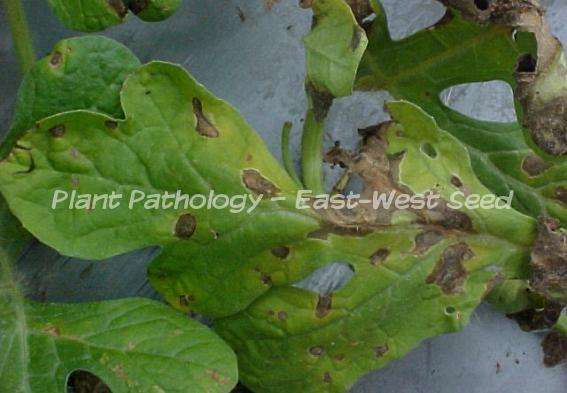Causal Agent:
Fungus (Alternaria cucumerina)
| Characteristic symptoms: | |
 |
Brown necrotic lesions initially appear on older leaves near the crown. |
 |
Affected leaves initially have small yellow brown spots with light green or yellow halo which eventually expand to large brown necrotic areas. |
| Conditions for Disease Development: | |
 |
The pathogen can survive for 1-2 years as mycelium in diseased plant debris. |
 |
Sources of primary inoculum are conidia produced by dormant mycelium in cucurbit fields with recent history of the disease and airborne conidia. |
 |
Conidia/spores produced on foliage are disseminated by wind, rain splashes, tools/implements and field workers. |
 |
Humid, rainy weather favours infection. |
 |
Disease severity increases with increased duration of leaf wetness (2-24hr) over a range of temperature (12-30°C). |
| Management and Control: | |
 |
Use resistant varieties, if available.
|
 |
Removal or deep plowing of plant debris after the cropping season can help reduce primary inoculum.
|
 |
Avoid overhead irrigation or prolonged moisture to reduce disease severity. |
 |
Staking increases air movement and may help reduce infection in the field. |
 |
Crop rotation with non-cucurbit crops for at least 2 years can reduce levels of primary inoculum.
|
 |
Regular application of protective fungicides such as copper-based fungicides (e.g. Cupravit®, Super BlueⓇ, Vitigran blueⓇ, FunguranⓇ, KocideⓇ, Hydroxide superⓇ), mancozeb (e.g. Attain M-80Ⓡ, Achem Mancozeb 80 WPⓇ, Micron 80 WOⓇ, VanzebⓇ) or propineb (e.g. AntracolⓇ) can delay the onset of the disease and slow its development. |
To view other diseases, click here.
Need more help? Ask the Doctor.





